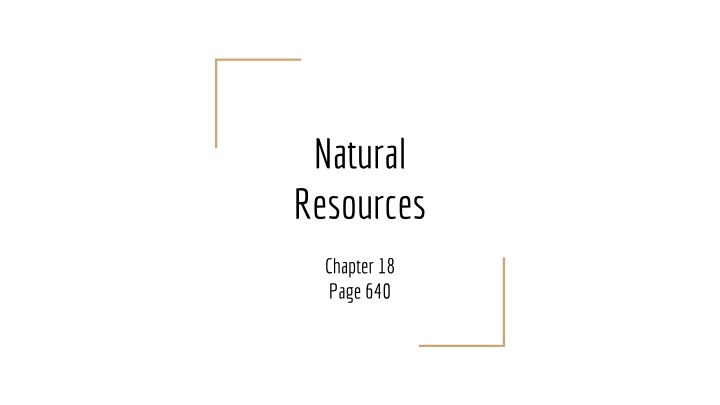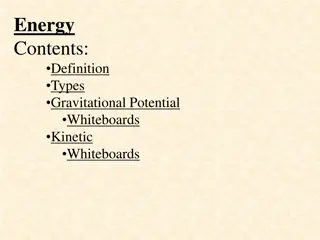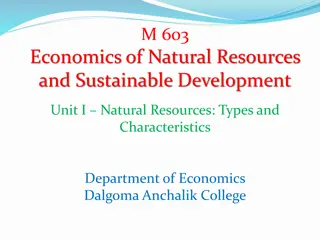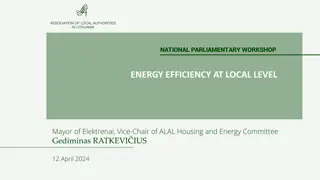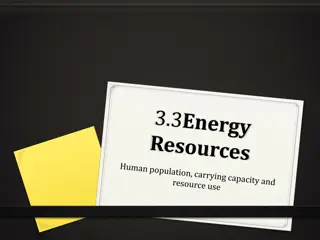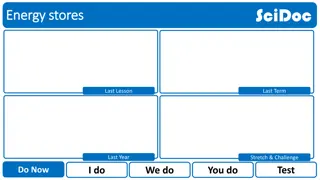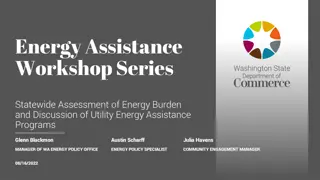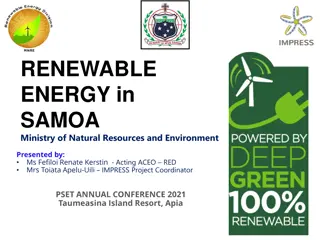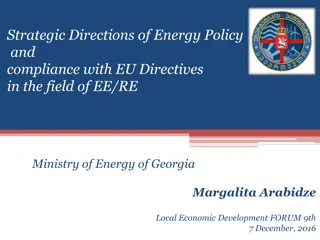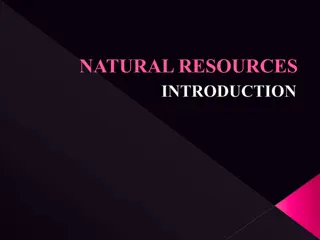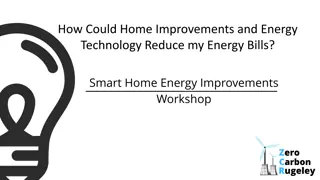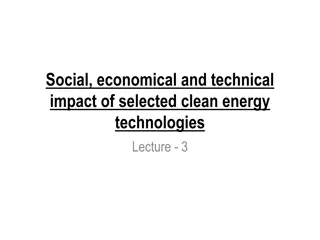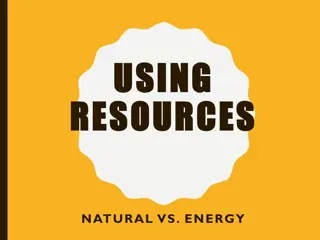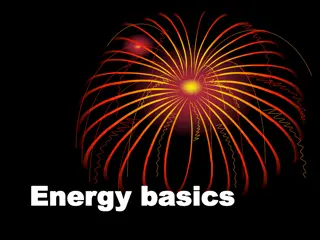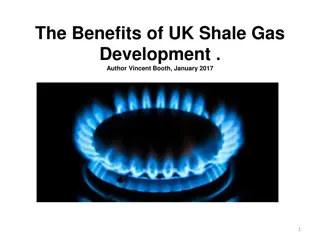Overview of Natural Resources and Energy
A natural resource is a material found in nature, either renewable or non-renewable, that can be used for economic gain. This includes energy resources like fossil fuels, coal, oil, and natural gas, which play a crucial role in providing power for various needs. The chapter delves into the types of energy resources, such as nonrenewable and renewable sources, with a focus on fossil fuels like coal, oil, and gas. It discusses the formation of these resources over millions of years and their pros and cons in terms of energy production and environmental impact.
Uploaded on Feb 25, 2025 | 0 Views
Download Presentation

Please find below an Image/Link to download the presentation.
The content on the website is provided AS IS for your information and personal use only. It may not be sold, licensed, or shared on other websites without obtaining consent from the author.If you encounter any issues during the download, it is possible that the publisher has removed the file from their server.
You are allowed to download the files provided on this website for personal or commercial use, subject to the condition that they are used lawfully. All files are the property of their respective owners.
The content on the website is provided AS IS for your information and personal use only. It may not be sold, licensed, or shared on other websites without obtaining consent from the author.
E N D
Presentation Transcript
Natural Resources Chapter 18 Page 640
What is a natural resource? Natural means it is found in nature and is not man made Resource are materials or substances that can be used for economic gain All natural resources are either renewable or non-renewable Natural resources can be used to form energy Energy is power from resources-can provide light & heat, transportation, to make machines work, and other needs
18.1 Energy Resources Nonrenewable: used faster than they can be replaced naturally-coal, oil, uranium Renewable: replaced naturally in a short amount of time-sun, wind, water Nonrenewable resources tend to be more expensive Chart p. 643
Fossil Fuels Nonrenewable; forms over millions of years; remains of animals & plants Uses extreme temperatures and pressure to change buried dead plants & animals into resources like coal, oil, petroleum, and natural gas 3 Factors determine the type of fossil fuel: type of organic matter, amount of pressure and temperature, and length of time buried Organic means made naturally
Coal Fossil fuel- bacteria, temps & pressure acted on dead plants to form peat Peat can be used as a fuel when burned Peat can also change into harder types of coal like anthracite Coal mines provide many jobs and help our economy grow Pics p. 644
Oil & Natural Gas Fossil fuel-bacteria, temps & pressure acted on plankton for millions of years to form natural gas. Plankton are microscopic marine organisms. Rock layers in the mantle of the Earth provide permeable rocks for less dense gas and oil to pass. Permeable refers to holes in rocks that a substance can pass through. Impermeable means nothing can pass through. Pic p. 645
Pros & Cons of Fossil Fuels Advantages: Change is easy and natural, inexpensive & easy to transport in tankers trucks, ships, and pipelines Disadvantages: nonrenewable, destroys animal habitats, pollution to land, water, and air, creates acid rain/snow that saturates the ground When mines are not used anymore, they have to be filled to prevent sinkholes
Nuclear Energy Energy released from atomic reactions. Atoms are tiny but release large amounts of energy like in stars Nuclear fission is used on Earth in power plants to produce electricity. Uranium atoms split and cause a chain reaction of more splitting atoms. The released energy heats water and produces steam. Steam turns turbine connected to a generator to make electricity. Pic p. 648
Pros & Cons of Nuclear Energy Advantage: small amounts of uranium produce large amounts of energy, no pollution Disadvantage: nonrenewable, must be carefully monitored and stored, expensive Waste from nuclear energy lasts thousands of years and is dangerously radioactive if not stored properly
Managing Nonrenewable Resources Fossil fuels and nuclear energy provide about 93% of US energy. Pic p. 649 Energy use in the US is higher than other countries and the US 22% of the world s total energy. Reclamation is a process in which mined land must be recovered with soil & vegetation. Laws limit amount of drilling to protect the environment. Clean Air Act limits pollution in air, US Atomic Energy Act & Energy Policy Act include regulations (rules) for nuclear waste.
What can you do to help? Vampire energy is the energy used when appliances are not unplugged and uses about 5% of annual energy. Conserve by unplugging DVD players, printers, toasters, hair dryers, etc Walk or ride your bike more often than riding in a car (be safe though) Increase use of renewable resources
18.2 Renewable Resources: Solar Energy Solar energy comes from the sun-light is transformed to electricity Active solar energy uses technology that gathers and stores solar energy that heats water and homes. Passive solar energy uses design elements that capture energy in sunlight like windows . Pic p. 653
Renewable Resources: Wind Energy Used since ancient times to sail boats and turn windmills. Wind turbines produce electricity on a large scale today. A group of wind turbines (pic p. 654) is called a wind farm-very popular in Holland, China, India, and the US (Hawaii) Largest wind farm is in China and has over 6000 windmills with plans to expand to 20,000 by the year 2020.
Renewable Resources: Water Energy Flowing H2O has been used as an energy source since ancient times too- producing hydroelectricity or tidal power. Hydroelectricity is when river dams causes water flow to turn turbines connected to a generator. As generator spins, electricity is produced. P 654 Tidal power is near the beach and uses the differences in high and low tides in a similar manner. Flowing water turns turbines connected to generators to produce electricity.
Renewable Resource: Geothermal Energy Earth s core is nearly as hot as the sun s surface and produces thermal energy which flows towards Earth s surface. People can drill wells to reach the heated rocks which heats water and produces steam which turn turbines hooked to generators. It is used to heat homes and generate electricity. Pic p. 655
Renewable Resource: Biomass Energy Produced by burning organic matter like wood, food, and alcohol. Wood is mostly used. Can be converted into fuel for vehicles. Ethanol is made from sugars in plants, like corn and is blended with gasoline. (watch the gas pumps) This reduces the amount of carbon monoxide and other pollutants released from vehicles. Biodiesel is made from vegetable oil and fats to reduce pollutants-fastest growing renewable fuel in the US now
Pros and Cons of Renewable Resources Advantages: availability, produce less pollution than fossil fuels, found in the United States (no imports or dependency on other countries) Disadvantages: costly, limited at times in certain areas
Managing Renewable Resources Only meets 7% of US energy needs Educate and encourage usage 2009 US Dept of Energy funded billions of dollars to study the efficiency of renewable resources Purchase products that are made using renewable resources How are renewable resources used at our school?
18.3 Land Resources People have always used land to meet their needs. We all require living space-animal habitats, buildings, sidewalks, parking lots, streets, etc. Most land in the US is used for agriculture, grasslands, and forests. See graph p. 661
Forests & Agriculture Forests cover much of the eastern US in 1650 but most of it disappeared by 1920-replaced with cities and farms See pic p 662 Forests were and still are cut for fuel, paper products, and wood products like furniture Forests are sometimes cleared for agriculture growth or some other development like a mall Today, about 1/5 of US land is used for agriculture and about 1/4 is used for grazing livestock (Ex: cows)
Minerals Minerals (ore) are mined from the land to make products we use every day Pic p. 663 Common items made from minerals: steel, fluorescent lights, paint colors, glass, insulation, brick, batteries, nails, faucets, wires, plastics, concrete, rubber, refrigerators, automobiles, lamps, electronics, etc . Different minerals are found in different regions around the world. Common minerals in Alabama are amethyst, calcite, fluorite, apatite, gypsum, magnetite, monazite, onyx, opal, quartz, turquoise, wavelite, etc. There are mineral and gem clubs in Montgomery and Huntsville
Pros and Cons of Land Resources Advantages: accessibility, availability, most are renewable by planting more Disadvantages: some take millions of years to renew, pollution, deforestation Pollution-runoff from mines affects the soil and water nearby, farmers use pesticides and chemical fertilizers that can pollute soil and water also Deforestation-cutting large areas of forests for human activity-leads to soil erosion and loss of animal habitats-can be a serious problem. Today there are laws for foresters to replant after cutting down forests.
Managing Land Resources The amount of land is limited! Govt can preserve forests and unique ecosystems Mined land must be restored to govt regulations Farmers can leave stalks after harvesting to protect soil from erosion Organic farming does not use chemicals as fertilizers or pest control
What can you do to help? RECYCLE Don t liter Plant gardens and trees Use yard waste and vegetable scraps to make compost for gardening instead of using chemicals
18.4 Air & Water Resources Obviously, we cannot live without air and water! General rule: survive 3 minutes without oxygen and 3 days without water. Air: pollution from fossil fuels, smog irritates respiratory system (asthma), creation of acid rain that falls in lakes to harm fish; dust and ash from forest fires and volcanic eruptions Water: 0.9% of all Earth s waters are for human use-drinking, farming, factory use, transportation, recreation, household activities, electricity production, etc
Managing Air & Water Resources Management must consider both human needs and other living things. Legislation (laws) to reduce pollution like the US Clean Air Act (1970), US Clean Water Act & Safe Drinking Water Act-ALL living things should have access to clean air and water What can you do to help? Energy efficient homes, change filters, use energy efficient light bulbs, dispose of paint and chemicals properly, pick up litter, conserve water (brushing teeth, long showers, leaky faucets, etc)
TEST TIME Study review p. 676 Complete, check, correct, and study p. 678 Know vocabulary Study Quizlet Make an A! :)
